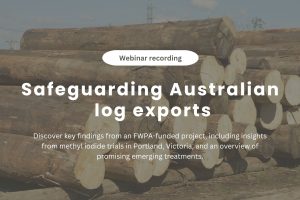A tool to predict fertiliser response and profitability in softwood plantations across Australia. Component 1: South West WA’ – Webinar summary of Project #VNC 476 1819
To improve the capacity of growers to readily predict the profitability of different fertiliser options on different sites FWPA supported the development and parameterisation of a tool, ProFert for Pine. By combining empirical results from fertiliser experiments across Victoria, Tasmania and South Australia with growth models used by individual growers, this tool predicts the response, increase in wood production and profitability of fertiliser use in softwood plantations.
The wider adoption and use of ProFert has been restricted due to uncertainty in the applicability of relationships based on results from experiments with P. radiata in south-eastern Australia to different parts of Australia. This project extended the applicability of ProFert to southern WA.
Analysis of WA softwood nutrition and silviculture trials has revealed strong trends in the factors that determine both plantation productivity and responsiveness to fertiliser. The limit to the productivity of plantations in the relatively dry and seasonally variable environment of southern WA is determined by water availability. In order of influence, water availability (measured as the ratio of rainfall to evaporation: R/E), phosphorus supply and then nitrogen supply are the major influences on productivity and responsiveness to fertiliser. Plantation density also has a strong influence on the responsiveness to fertiliser as it influences the availability of water. Calibrations for these factors have been developed and incorporated into a version of ProFert tailored specifically for southern WA.
Presenters:
Dr John McGrath has 40 years’ experience in ecophysiological research in conifer and hardwood species across Australia. Initially this work has focussed on understanding the nutrient, water, soil and climatic limitations to tree growth in WA and has provided a strong understanding of the strategies required to effectively manage plantations and tree crops in WA. Since 2014 Dr McGrath has been involved in developing silvicultural systems for the emerging African mahogany plantations in the dry tropics of northern Australia and has been involved in a series of hardwood and softwood projects aimed at optimising the productivity of plantation systems in southern Australia.
Dr Barrie May has 30 years’ experience working with growers across Australia and overseas to improve nutrient management and model growth and profitability of their plantations. He has extensive skills in nutrition, growth modelling, carbon accounting and economic analysis. At CSIRO, Dr May was responsible for running a network of nutrient management trials in softwood plantations across the Green Triangle. As a private consultant Dr May used the results of this work to develop of the ProFert fertiliser optimization tool which predicts the end-of rotation profitability of fertiliser use on specific sites. With support from the FWPA and industry collaborators, this tool was recently improved and adapted for use in softwood plantations across south eastern Australia and is now being used operationally by a number of growers in Tasmania, Victoria and South Australia.



